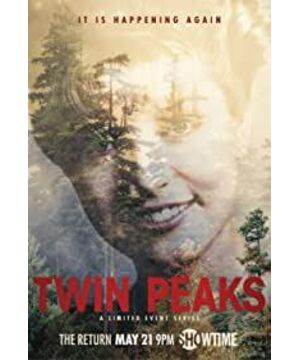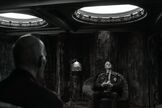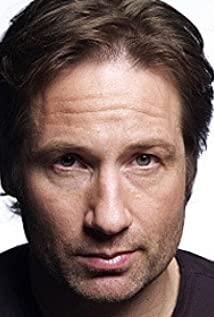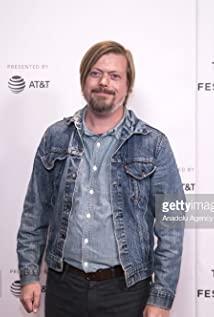The wonderful fusion of cult temperament, contemporary art and mass entertainment is nothing more surprising than Lynch’s breakthrough in the tail of his creative career.
We were expecting the return of the mysterious, humorous and psychedelic detective drama of "Twin Peaks" in the 90s, but Lynch unexpectedly brought the third season of restless, melancholic and full of modern art. Among them, the reference to contemporary painting art, my own creative career, a more direct female perspective, and the parallel narration of multiple realities by breaking the continuity make the third season enough to get rid of the title of the serial sequel and become an independent ultra-long film work. .
This article re-examines the relationship between Shuangfeng's third season and David Lynch's creative career with the following parts and a comparative perspective, and hopes to arouse everyone's enthusiasm to continuously explore Shuangfeng's third season.
· 25 years of feelings
· "Modern people are under great pressure"-the expansion and evolution of the Twin Peaks world
· "Dig yourself out of the pit"-Lynch's pity throughout his career
· "Elegy for the Victims of Hiroshima"
· Lynch's visual style-back to the beginning
· The development of narrative: the break of continuity and the mixing of official/unofficial version
· The key to solving the mystery
25 years of feelings
The special thing about the return of the "Twin Peaks" series after 25 years is that Lynch will not use images to fill the story of the past 25 years, so the world of Twin Peaks and the real world have achieved a wonderful synchronization. The decline of the lumberyard and the clamor of electronic music make us unfamiliar, just as the death of the actor Pete and Log Lady made us regret. One of the most touching moments of the season Part 11 ended with the sound of "Heartbreaking". Lynch, who refused to use flashbacks to explain the story of 25 years, put all the emotions of nostalgic into this place. We listened to Dougie together, maybe there was a moment. Also wake up together.
"Modern people are under great pressure"-the expansion and evolution of the Twin Peaks world
The story of the 90s takes place in a closed American town. It looks as sweet and simple as the small town movies of that era, even though it is being eroded by drugs and domestic violence. Twenty-five years later, the social changes are accompanied by the expansion of the location of the story, from Washington, South Dakota to New York. During the period in the third season, we discovered that Twin Peaks has merged into the outside world-it is no longer so unique.
In the world of the new work, the effects of drugs and violence have become obvious, and the pressure and anxiety of modern people cannot be concealed. This is the bruise of social change and Lynch's self-return-"The world is wild at heart, weird on top!". After all, American towns and middle-aged life have always been the object of his irony, and "Blue Velvet" officially reveals Lynch's representative work on the dark side of modern life. In "Two Peaks: Return", the vomiting driver and the Quentin-style street gunfight are exaggerated and puzzling. This is a concrete expression of contemporary anxiety, just like the driver who hits a deer in "Mr. Streit's Story."
"Dig yourself out of the pit"-Lynch's pity throughout his career
Lynch’s work can be understood openly. If there is anything in the new work that is in the same line as Lynch in the 1980s and 1990s, it is the female perspective on sex, violence, and family fears. Lynch put his emotional side into Badalamenti's music, into his pity for the women victimized in works such as "Blue Velvet" and "Inland Empire", and of course Laura, Audrey, and Nadine. The first reality scene in the opening chapter of "Two Peaks: Return" is the shovel craft of Dr. Jacoby, and this line connects with Big Ed and other old friends in Shuangfeng Town throughout. This reflects from the side that Dr. Jacoby is also an important entry for understanding "Twin Peaks: Return".
In the original "Twin Peaks", the women in this sweet town have more or less encountered domestic violence. In addition to the murdered Laura, Shelly and Norma are still trapped in the quagmire of hesitation and weakness. In the new work, Lynch gives guidance. Starting from Nadine, she heard the doctor's call, faced herself honestly, and finally confided her heart to Big Ed and rescued herself from the cage. Ed and Norma finally broke through the barriers of relationship and life and took a firm step towards reunion.
Just like the angel's rescue of Laura in "Twin Peaks: Walking with Fire", Lynch, with a gloomy and dark style, always retains tenderness for the victimized women, of course you have to rely on your own "ACT OUT!"
"Elegy for the Victims of Hiroshima"
Even Lynch’s most loyal fans who have appreciated the blood and flesh of "Alphabet" and the blur of "Inland Empire" will still be stunned at Part 8 of "Twin Peaks: Return". The introduction of the surrealist style into the detective drama in the original Red Room scene is considered a milestone. The new work in this episode of the dialogue with Kubrick’s human fables is completely Experimental Episode. Baladamenti, Penderecki and Nine Inch Nails three styles of soundtrack, Woodsman's supernatural scenes, Dr. Qi Ai and space roaming visual wonders together constitute this hour of "modern drama."
This is a mystery-style episode, and it is also another expansion of the bimodal pattern. One of the historical significance of the original work is that it makes full use of the possibility of unlimited expansion of the story of the TV series, and it has also deeply influenced the generation of producers such as JJAbrams and Damon Lindelof. With the official opening of the original "Double Peaks", we were able to see a large number of "brain-hole type" excellent American dramas in the new century. This time, the originator Lynch played more interestingly: He attributed the demons of Twin Peaks such as Bob and Woodsman to the birth of the atomic bomb-the extreme form of "The evil that men do". The identity of the Giant character in the previous work is also revealed in this episode: the divine Fireman. Fireman gave Laura a mission. Although this mission and method are still vague, it tells us that if we understand it from a larger format, the "Twin Peaks" series is about the story of human self-salvation under the guidance of the gods.
Lynch has always been a director who relies on intuition and insists on self-expression. Although he never interprets his own works, I believe that he must incorporate a lot of personal life experience. For example, the chaotic Philadelphia time and the fear of unmarried pregnancy are clearly visible in "Rubber Head" and "The Elephant Man", and the pleasant small town life of childhood has also turned into a white fence in "Blue Velvet". This time, Lynch and Frost, two authors who grew up during this special period in the 1950s, projected the "nuclear fear" psychology of the generation that had experienced nuclear warfare exercises into Shuangfeng. Woodsman's killing and monologue on the radio station can also be understood as a dramatic expression of the spread of this panic.
More importantly, this episode is not only a combination of imaginative, courageous and ambitious director’s personal experience and parody fun, but also embedded Lynch’s unique aesthetic style in visual performance. It will " The paradox of "Double Peaks" is pushed to the extreme, and it has a strong personal touch.
Lynch's visual style-back to the beginning
David Lynch was originally inspired to become a painter in his youth. Compared with film training, he accumulated more painting skills, so his early short films are closer to the combination of animation and installation art. Since David Lynch gradually abandoned modernist painting elements after the production of the feature film, the “Linchism” we usually talk about seems to have overlooked a considerable part of his characteristics. Finally, in the double peaks at the end of his creative career, we seemed to see the early Lynch from the visual effects, and also the more pure Lynch who lived an artistic life.
The special effects in the real world in the plot of "Shuangfeng: Return" are based on realism, while in several surreal environments, Shuangfeng uses simple and weird special effects that are close to the painting style. We may understand this weirdness as a Brecht-like alienation effect, but from the several obvious imitations of the expressionist painter Francis Bacon’s paintings in the film, we can see that Lynch is pursuing him. The specific painting aesthetic in the heart is also an obvious feature of the integration of contemporary art in this work.
The development of narrative: the break of continuity and the mixing of official/unofficial version
In the early days of the third season, the theory of "bait Laura screaming to detonate Judy" was widely spread on the Internet. This is also the first fan theory that can explain the plot of the third season in a more self-justified manner. However, with everyone's excavation and discussion of the massive details of "Twin Peaks: Return" and the analysis of the timing of each scene in the third season, this simple theory has become untenable. To better understand Shuangfeng's "story", there are still many factors that need to be considered.
Let's not talk about the answer, let's talk about the style first.
The alternate narrative of reality and subconsciousness is the narrative style that Lynch tried repeatedly in the middle and late stages of film creation. In such a framework, Lynch may use the Mobius ring-like closed structure, or create surreal mysterious characters, or develop multiple levels of entangled subconsciousness, and develop his own complex and fascinating forest. Singularism. In the previous feature films, although the boundary between reality and the subconscious is blurred, David Lynch always tries to adopt an alternate narrative, that is, once we find the boundary of the "dream", we can roughly distinguish the world in different scenes. , This is how we usually "crack" Lynch movies.
In "Shuangfeng: Return", the narrative technique becomes vague and absurd.
According to Part 17, the split of the story occurred through Cooper’s journey to save Laura, in the form of two parallel worlds, the "Official version" where Laura was saved and the "Unofficial version" where Laura was killed in the original work. This is also in the subsequent published novels. Has been fully confirmed. The subtle thing is that, unlike any previous work, the main storyline of "Twin Peaks: Return" obscurely breaks the continuity within the camera, burying multiple jumps between the two version worlds under the same scene.
In the scene where Diane was shot to death by Albert and Tammy, careful observation revealed that after the shot of Diane drawing the gun, there was an Albert shooting shot that lasted only a few frames. At this time, Tammy disappeared from the screen; when Diane was shot again When switching back, the screen showed that Albert and Tammy were shooting at the same time. It can be inferred from Tammy's precautionary action to draw the gun beforehand and the spatial relationship between the person and the table in the picture. Tammy's disappearance cannot be accidental lying under the table in an instant, but a carefully designed set of shots that break the continuity. This is a typical scene where multiple realities are confused in the narrative.
Back before, when Diane received Mr.C's instructions to go upstairs to kill Gordon and the others, there was a mess of reality. Before she approached the elevator, the position of the two bracelets on her right hand changed when she walked out of the elevator. In this group of continuous shots, the change in the position of the bracelet is unlikely to be an omission in the shooting process. During the interrogation of Diane, the camera repeatedly gave "Gordon who will remember the'unofficial version'" to look up and down Diane. It seems that this confusion also caused his memory of different realities.
This begs a question: In which version did the FBI team's tracing process that we saw in the third season occurred, and is it still a follow-up to the murder of Laura in the original "Twin Peaks" world? The answer may only be: Lynch cunningly cut them together.
This kind of jump between the two parallel worlds is more obvious in the scene of the RR restaurant at the end of Part 7: a man suddenly broke in and asked if anyone saw Billy. In such a series of seemingly continuous shots, we can observe carefully that before and after the man broke in, the actors and positions of the restaurant customers have completely changed. Of course, this is not a time jump, but a mixture of the realities of the two versions.
Now that Billy is mentioned, the strange characters in Roadhouse that we have seen many times at the end of the film, as well as the entanglement of Audrey, Charlie, Billy, and Tina, have also been explained: these are the daily trivia of Twin Peaks in another version. In this parallel reality, Audrey was not raped by Mr. C to give birth to a child, and the memory of this world will penetrate into another version, Audrey who lives in the hospital.
Therefore, the impact of Cooper's rescue of Laura through time not only occurred in Part 18, but penetrated into the details of the third season. Lynch has created "fake continuity" in many places in the play, eliminating the boundaries of multiple worlds. This subtle technique blends with the grotesque temperament of the third season. It is Lynch that we have never seen before.
The key to the mystery
Although the previous work is mysterious enough, "Twin Peaks: Return" brings more questions than answers. The legend of Judy, the appearance of Naido, and the connections and motives of the surreal characters in the play have become more and more difficult to understand as the plot progresses. Maybe Fireman and Lodge residents are a simple opposition between good and evil, or maybe the surreal characters are just the concrete expressions of the subconsciousness that Lynch is used to? In order to further understand this work, there are some such details that may be worth thinking about.
1) Judy created the world of Carrie Page?
At the end of Part 17, Cooper, who traveled through the past, tried to bring Laura back to "home", but Laura disappeared in the jungle. The "Laura Bait Theory" interpreted this as Fireman taking Laura away and placing her in another world to lure Judy, and then realize the "two birds with one stone" plan. But when we carefully analyze the sound effects of this scene, we can find that Laura disappeared and a strange noise similar to "grabbing plastic" appeared, accompanied by screams. This kind of noise is what Fireman told Cooper to listen to in Part 1.
Fireman: "Listen to the sounds...It is in our house now..."
This can be understood as Fireman warning Cooper that Judy has acted again, rather than the voice created by Fireman himself. In addition, when Fireman was "transmitting" characters, such as Cooper and Andy, they disappeared instantly and accompanied by electrical noise. It can also be inferred that "grabbing plastic" and painful screams were not caused by Fireman's actions. Therefore, the disappearance of Laura is the result of Judy's intervention in the rescue operation. The matching of sound effects and dialogue also shows that the time of the Fireman scene in Part 1 was after the failure of Cooper's rescue operation, so Fireman further warned that "You are far away... ". According to this logic, there are many loopholes and contradictions in the interpretation of the "two birds with one stone" plan in the "Laura decoy theory".
2) Judy, Jumping man and Sarah
Sarah has always been one of the most miserable figures in the Twin Peaks world. She has not only witnessed domestic violence and deception, but also suffered the loss of her daughter in 25 years. In the third season, Sarah's storyline is a process in which a traumatized mother is gradually eroded by evil. So, when did Judy occupy Sarah? Was it the curse symbolized by "Frog Moth" crawling into Sarah's mouth in Part 8, or Sarah who only invaded in the third season? Palmer's house may provide some clues.
Although the shooting span was not long, Lynch designed the shrubs in front of Palmer's house: throughout the season, the panoramic view of the house appeared four times, and only in Part 12, where Sarah's behavior had a major turning point, the shrubs in front of the house blocked the windows.
When Mr. C entered the White Lodge, Fireman was looking at Palmer's house on the screen, and what he was looking at was exactly the best location in Part 12. So what else happened in this episode? When Hawk visited Sarah, he heard an unusual noise in the kitchen, and Sarah just murmured. This may be the moment when evil really completely erodes Sarah, and maybe Mr.C in the house, or maybe Judy.
3) Cooper's badge change and timeline
In the third season, the narrative sequence of Cooper's actions is as follows (Dougie is omitted):
Talk to Fireman*
Red room, purple room scene
Reunion of Shuangfeng Town Police Department*
Say goodbye to Diane/Gordon and enter the Great Northern Hotel
Cross to save Laura
(Again) Get out of the red room and meet Diane
Find Carrie Page
Considering Lynch's cunningness, the actual sequence of the story may not follow this, and not all paragraphs have actually happened. In all actions, two points are confusing:
A) Cooper walked out of the red room twice, one was to start a dream trip to Las Vegas based on Naido's guidance, and the other was to open the curtain and walk out of the forest to meet Dian. During the two walks out of the red room, there were scenes of Laura whispering with Cooper (the second time was more like Cooper's memory), but the lines of The Evolution of the Arm changed. Cooper heard Laura whispering The reaction is also slightly different. So, these two paragraphs that are similar in the process but were shot separately, which one is Cooper's real experience?
B) Cooper, who entered the Red Room in the second season, wore the FBI badge, and in the third season (when Cooper had regained the consciousness of FBI agents), there were two paragraphs that did not wear the badge (marked with *). And this detail may indicate the sequence of these events. Did Fireman remind Cooper that the "One Stone Two Birds" plan occurred after the Shuangfeng Town Police Station dimmed before they entered the Great Northern Hotel?
4) Gordon who is not confused
In the works of Shuangfeng Town, Gordon always appears in a dull and confused image, but this is only his appearance. Gordon has the most information about the Blue Rose case. He was the first to confirm the existence of "Two Coopers" with the help of Dreamland. More importantly, he has close ties with Briggs, Cooper and Phillip and participated in the formulation of " "One stone, two birds" plan. Therefore, although the character of Gordon is a humorous element in the film, he is also a core member in the struggle with demons such as Judy and Bob, and an excellent agent. In addition, as mentioned above, he can remember the "unofficial version" in the chaotic real world.
In all Gordon's passages, the long and weird scene in the same room where he and the French woman and Albert are shared, you must not laugh at it. In the opening scene of the FWWM, due to the particularity of the case, Gordon used a strange female body language to convey information to Agent Chet (ie their Modus Operandi), and referred to the code as "Mother's sister". In the third season, the French woman's paragraph is very similar, and Gordon also suddenly mentioned "Mother's daughter", which may be the key message for Gordon to pass the Blue Rose case to Albert. When Albert hesitated, Gordon gave another reminder: "There are more than 6000 languages in the world." If Albert still can't notice this "body language", it's no wonder Gordon is "very worried" about him.
One year has passed since the third season of Shuangfeng was broadcast. Unlike previous works, fans seem to have encountered insurmountable obstacles in "decoding" this work. However, this does not prevent us from appreciating the charm of Lynch's works. The dark side of modern life, the compassion of a female perspective, Lynch's unique visual aesthetics, and the changing narrative technique of another appearance make it a masterpiece of this artist, which is destined to leave a deep mark in the history of film and television art.
View more about Twin Peaks reviews











